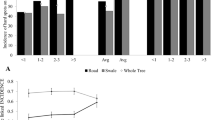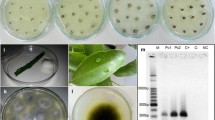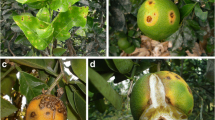Abstract
Citrus Black Spot (CBS), caused by Guignardia citricarpa, was detected for the first time in Ghana and in West Africa. The disease was first observed in the Eastern Region in 1999 with typical disease symptoms including hard spot, virulent spot and false melanose were observed on several citrus species. A survey revealed that the disease has reached epidemic levels in the citrus-producing areas of the Eastern and Ashanti regions and is spreading rapidly within these areas and to other regions of the country. Currently, CBS is the most important fruit disease of citrus in Ghana, causing about 22% crop loss. Although the disease does not cause postharvest decay and the internal quality of the fruit is not affected, significant amounts of blemished fruit are discarded at the markets. Disease incidence and severity was found to be higher on mature than on young citrus trees. Pycnidia were found on fruit with hard spot symptoms, and pycnidia and pseudothecia typical of Guignardia spp. were found on decomposing leaves. Two species, G. citricarpa and G. mangiferae, were isolated from 15% of the samples collected and identified using the Oatmeal Agar test and by PCR with species-specific DNA primers. Isolates of G. citricarpa produced CBS symptoms after 80 to 233 days on 75% of the artificially inoculated young fruit of Valencia Late sweet orange. The fungus was re-isolated from symptomatic, inoculated fruit completing Koch’s postulates. Isolates of the endophyte G. mangiferae did not induce symptoms in the pathogenicity tests. In epidemiological studies, infections were detected from November to February for the minor cropping season and from May to November for the major season. Fruit of Valencia Late sweet orange were susceptible to G. citricarpa infection for up to 7 months after petal fall. Knowledge of the disease cycle in Ghana will improve methods for disease control.



Similar content being viewed by others
References
Baayen, R. P., Bonants, P. J. M., Verkley, G., Carroll, G. C., van de Aa, H. A., de Weerdt, M., van Brouwershaven, I. R., Schutte, G. C., Maccheroni, W., Jr., Glienke de Blanco, C., & Azevedo, J. L. (2002). Nonpathogenic isolates of the citrus blackspot fungus, Guignardia citricarpa, identified as a cosmopolitan endophyte of woody plants, G. mangiferae (Phyllosticta capitalensis). Phytopathology, 92, 464–477.
Baldassari, R. B., Reis, R. F., & de Goes, A. (2006). Susceptibility of fruits of the ‘Valência’ and ‘Natal’ sweet orange varieties to Guignardia citricarpa and the influence of the coexistence of healthy and symptomatic fruits. Fitopatologia Brasileira, 31, 337–341.
Baldassari, R. B., Wickert, E., & de Goes, A. (2008). Pathogenicity, colony morphology, and diversity of isolates of Guignardia citricarpa and G. mangiferae isolated from Citrus spp. European Journal of Plant Pathology, 120, 103–110.
Baldassari, R. B., Reis, R. F., & de Goes, A. (2009). A new method of inoculation of fruit with Guignardia citricarpa, the causal agent of citrus black spot. European Journal of Plant Pathology, 123, 1–4.
Benson, A. H. (1895). Black spot of the orange. The Agricultural Gazette of New South Wales, 4, 249–252.
Brentu, F. C. (2012). Importance, etiology and control of a fruit spot disease of sweet orange. PhD. dissertation. University of Ghana, Accra (submitted).
Brodrick, H. T., & Rabie, C. J. (1970). Light and temperature effects on symptom development and sporulation of Guignardia citricarpa Kiely on Citrus sinensis (Linn) Osbeck. Phytophylactia, 2, 157–164.
Chiu, R. J. (1955). Studies on black spot of citrus. Journal of Agricultural Forestry, 9, 1–8.
Dewdney, M. M., Peres, N. A., Ritenour, M., Schubert, T., Atwood, R., England, G., Futch, S. H., Gaver, T., Hurner, T., Oswalt, C., & Zekri, M. A. (2010). Citrus black spot in Florida. Citrus Industry, 91, 18–21.
Dickson, K. B., & Benneh, G. (1995). A new geography of Ghana (p. 169). London: Longman group Ltd.
Fagan, C., & de Goes, A. (1999). Efeito da severidade da mancha preta dos frutos cotricos causada por Guignardia citricarpa an queda de frutos de laranja ‘Natal’. Fitopatogia Brasileira, 24, 282.
FAOSTAT (2009). Retrieved July 18, 2011, from http://faostat.fao.org/
Huang, C. S., & Chang, S. L. (1972). Leaf infection with citrus black spot and perithecial development in relation to ascospore discharge of Guignardia citricarpa Kiely. Journal of Taiwan Agricultural Research, 21, 256–263.
Kiely, T. B. (1948). Preliminary studies on Guignardia citricarpa n.sp.: The ascigenous stage of Phoma citricarpa McAlp. and its relation to black spot of citrus. Proceedings of the Linnean Society of New South Wales, 73, 249–292.
Kotzé, J. M. (1981). Epidemiology and control of citrus black spot in South Africa. Plant Disease, 65, 945–950.
Lee, Y. S., & Huang, C. S. (1973). Effect of climatic factors on the development and discharge of ascospores of the citrus black spot fungus. Journal of Taiwan Agricultural Research, 22, 135–144.
McOnie, K. C. (1964a). The latent occurrence in citrus and other hosts of a Guignardia easily confused with G. citricarpa, the citrus black spot pathogen. Phytopathology, 54, 40–43.
McOnie, K. C. (1964b). Source inoculum of Guignardia citricarpa, the citrus black spot pathogen. Phytopathology, 54, 64–67.
McOnie, K. C. (1964c). Orchard development and discharge of ascospores of Guignardia citricarpa and the onset of infection in relation to the control of citrus black spot. Phytopathology, 54, 1448–1453.
McOnie, K. C. (1967). Germination and infection of citrus by ascospores of Guignardia citricarpa in relation to control of black spot. Phytopathology, 57, 743–746.
Meyer, L., Slippers, B., Korsten, L., Kotzé, J. M., & Wingfield, M. J. (2001). Two distinct Guignardia species associated with citrus in South Africa. South African Journal Science, 97, 191–194.
Mondal, S. N., & Timmer, L. W. (2002). Enviromental factors affecting pseudothecial development and ascospores production of Mycosphaerella citri, the causal of citrus greasy spot. Phytopathology, 92, 267–275.
Ofosu-Budu, K. G. (2003). Performance of citrus rootstocks in the forest zone Ghana. Ghana Journal of Horticulture, 3, 1–9.
Ofosu-Budu, K. G., Monney, E. O., Quaye, E., Amankwah, A., Mintah, P., Mpere-Asare, C., & Agboka, M. (2007). Citrus production in Ghana (p. 108). Accra: Horticulture Export Industry Initiatve, Ministry of Food and Agriculture.
Peres, N. A. R., & Timmer, L. W. (2003). Citrus black spot caused by Guignardia citricarpa. CABI Crop Protection Compendium. Oxford: CAB International.
Peres, N. A., Harakava, R., Carroll, G. C., Adaskaveg, J. E., & Timmer, L. W. (2007). Comparison of molecular procedures for detection and identification of Guignardia citricarpa and G. mangiferae. Plant Disease, 91, 525–531.
Reeder, R., Kelly, P. L., & Harling, R. (2009). First confirmed report of citrus black spot caused by Guignardia citricarpa on sweet oranges (Citrus sinensis) in Uganda. Plant Pathology, 58, 399.
Reis, R. F., de Goes, A., & Timmer, L. W. (2006). Effect of temperature, leaf wetness, and rainfall on the production of Guignardia citricarpa ascospores and on black spot severity on sweet orange. Fitopatologia Brasileira, 31, 29–34.
Schabenberger, O., & Pierce, F. J. (2002). Contemporary statistical models for the plant and soil sciences (p. 738). Boca Raton: CRC.
Spósito, M. B., Fernández, N. G., & Feichtenberger, E. (2005). Manual de pinta preta (p. 11). Araraquara: Fundecitrus.
Spósito, M. B., Amorim, L., Bassanezi, R. B., Bergamin-Filho, A., & Hau, B. (2008). Spatial pattern of black spot incidence within citrus trees related to disease severity and pathogen dispersal. Plant Pathology, 57, 103–108.
Sutton, B. C., & Waterston, J. M. (1966). Guignardia citricarpa. CMI descriptions of pathogenic fungi and bacteria No. 85 (p. 2). Wallingford: CAB International.
Tuite, J. (Ed.). (1972). Plant pathological methods: Fungi and bacteria (p. 239). Minneapolis: Burgess Publishing Co.
UNECE. (2010). Standard FFV-14 concerning the marketing and commercial quality control of citrus fruit (p. 12). Geneva: United Nations Economic Commission for Europe.
Whiteside, J. O. (1967). Sources of inoculum of the black spot fungus, Guignardia citricarpa, in infected Rhodesian citrus orchards. Rhodesia, Zambia and Malawi Journal of Agricultural Research, 5, 171–177.
Acknowledgments
We thank Dr. K.G. Ofosu-Budu, then Head of Centre (FOHCREC), and Prof. Anna Barnes, Provost, College of Agriculture and Consumer Sciences (CACS), of the University of Ghana who obtained funding from the Agricultural Services sub-Sector Investment Programme (AgSSIP), financed by the World Bank, to conduct this work. We are grateful to Mr. Nii George Ankra Ankrah, Mr. Badu Darkwa and Mr. Adu-Gyamfi for technical assistance in setting out experiments and data collection.
Author information
Authors and Affiliations
Corresponding author
Rights and permissions
About this article
Cite this article
Brentu, F.C., Oduro, K.A., Offei, S.K. et al. Crop loss, aetiology, and epidemiology of citrus black spot in Ghana. Eur J Plant Pathol 133, 657–670 (2012). https://doi.org/10.1007/s10658-012-9944-1
Accepted:
Published:
Issue Date:
DOI: https://doi.org/10.1007/s10658-012-9944-1




